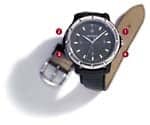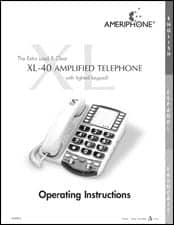Directional microphones are designed to collect sounds from a desired direction and attenuate sounds coming from other directions. They have been applied to hearing instruments for several years and have proven to significantly increase speech intelligibility in various noisy environments (see articles by Ricketts and Mueller1,2 for a review).
As described by Powers & Hamacher,3 we have recently observed three major advances in directional hearing instruments: 1) the use of a three-microphone array; 2) automatic switching or transition between directional and omnidirectional modes, and 3) the use of an adaptive directivity polar pattern. This article will primarily focus on adaptive directivity, describing how this feature is designed, and reviewing four behavioral studies that have been conducted using subjects fitted with the Siemens TRIANO S (dual-microphone) and TRIANO 3 (three-microphone) hearing instruments.
Design of Adaptive Directivity
In advanced hearing instruments, the directivity is achieved by use of two nearby omnidirectional microphones in endfire geometry, followed by a signal-processing unit in which the two microphone signals are differentially combined (first-order subtractive array) to create a direction-dependent sensitivity. The advantage of this approach is that it allows automatic matching of microphone sensitivities and change to an omnidirectional characteristic when the direction of the target signal differs from the assumed front direction (eg, having a conversation in a car).
Figure 1. Signal processing of a first-order differential microphone and resulting super-cardioid pattern when Ti/Te = 0.57.
As shown in Figure 1, the signal of the rear microphone is delayed and subtracted from the signal that is received by the front microphone. The directivity pattern of the system is defined by the ratio of the internal delay (Ti) and the external delay (Te) corresponding to the microphone spacing (typically 7-16 mm). In this example, the ratio was set to 0.57 resulting in a super-cardioid pattern, as shown on the far right of Figure 1. To compensate for the first-order high-pass characteristic introduced by the differential processing, an appropriate low-pass filter (LPF) is added to the system.
Figure 2. Relationship between the direction of the directivity notch and the ratio of internal and external delay. As the ratio increases from 0 to 1, the directivity notch moves from the 0° to the 180° azimuths.
Figure 2 shows that the direction of lowest sensitivity (or directivity notch) can be controlled by the ratio Ti/Te. If Ti/Te is changed from 0 to 1, the spatial notch moves continuously from 90° to 180°.
Figure 3. Basic principle of an adaptive directional microphone. The directivity notch is adjusted so as to adaptively attenuate those signals that are deemed to be noise (from sides and behind user).
This effect can be exploited to enhance the directional performance in various everyday situations with noise originating from a specific location. The adaptive directional microphone continuously adapts its directivity pattern by Ti/Te variation to the respective noise field so that the directivity notch matches the direction of noise arrival. In this way, the noise suppression effect is designed to be automatically maximized in a variety of everyday listening situations which often differ in direction of noise incidence (Figure 3).
Figure 4. Method of Elko & Pong4 for adaptation of the directivity pattern based on the weighted sum of the output signals of two simultaneously calculated directional microphones with bi-directional and cardioid characteristic.
To be accessible for the adaptation system, the internal delay has to be applied in the digital processing domain of the hearing instrument. However, this would require the realization of fractional delay filters. Since these filters would cause a high computational effort, the adaptive directional microphone of TRIANO™ hearing instruments uses an efficient method as proposed by Elko & Pong.4 As shown in Figure 4, the shape of the directivity pattern is managed by a weighted sum of the output signals of a bi-directional and a cardioid pattern. In the digital domain, these can be calculated simultaneously. The position of the directivity notch is directly (monotonically) related to the weighting factor.
To be beneficial in the dynamic noise fields of everyday situations, the management of the directional notch has to be reliable and accurate. Additionally, it should not introduce artifacts or perceivable changes in the frequency response for the 0° (directly in front) target direction, which could be irritating or annoying for the user. Finally, the adaptation process must be fast enough to compensate for head movements and to track moving sources in common listening situations, such as conversation in a street cafe with interfering traffic noise.
The algorithm implemented in the TRIANO adaptive directional system is designed to fulfill these requirements. The adaptation time for a noise source rapidly moving from 180° to 90° is less than 50 ms, which is sufficient for the dynamics of most listening situations. To ensure that no target sources from the front hemisphere are suppressed, the directivity notches are limited to the back hemisphere (90°-270°). Additionally, the depth of the notches is limited to prevent hazardous situations for the user (eg, when someone is crossing the street and a car approaches).
Figure 5. Suppression of a noise source (500 Hz) moving around the KEMAR for the TRIANO 3 (mounted on left ear) with directional microphone in adaptive mode (blue line) and non-adaptive mode (red line).
Figure 5 shows a measurement in an anechoic test chamber with an adaptive directional microphone hearing instrument (TRIANO 3 BTE, linear amplification mode, noise reduction deactivated) mounted on the left KEMAR ear. A noise source (500 Hz) was moved around the head and the output level of the hearing aid was recorded (blue line). Comparing the same measurement for a non-adaptive super-cardioid directional microphone (red line), one can clearly see the higher suppression effect for noise incidence from the rear hemisphere.
While the laboratory data with adaptive directional microphone hearing instruments has been encouraging, it is also important to consider how these instruments affect the understanding of speech with human subjects. It is well known that electroacoustic benefits observed in an anechoic chamber might not translate to improved speech understanding in noise in real-world settings. In the past year, several studies have been conducted with the adaptive directional hearing instruments discussed, and four studies have been selected here for review.
Effects in Diffuse Noise Field
In research5 conducted at the Hoerzentrum Oldenburg GmbH in Germany, TRIANO dual- and three-microphone BTE models were compared to a well-known competitive dual-microphone BTE for both the fixed and adaptive directional microphone modes. Testing was conducted using the adaptive Oldenburg Sentence Test to determine the speech reception threshold in noise for sentences. The test score is denoted as L50—the signal-to-noise ratio (SNR) at which 50% of speech is understood. All testing was conducted in a large reverberant room using a speech-shaped noise presented at 70 dB SPL. Two different loudspeaker arrangements were used for presenting the noise stimuli: 5 surrounding loudspeakers placed within the diffuse field and a second arrangement of 9 surrounding loudspeakers placed outside the diffuse field.
The results were similar for both test environments, so we will summarize the general findings. When the hearing instruments were tested in the fixed-directional mode, the mean L50 for TRIANO S and competitive aid were now essentially the same, both significantly poorer (by 2.5 dB) than that of TRIANO 3, and it was also superior to the competitive directional aid (about 2.0 dB). Similar results were obtained when the hearing instruments were set in the adaptive-directional mode, except that the mean L50 for TRIANO S and competitive aid were now essentially the same, both significantly less (by 2.5 dB) than that of TRIANO 3. The fact that the adaptive setting of TRIANO did not result in improved performance over the fixed setting was an expected finding: the noise was not moving, nor was it originating from a specific location. The finding showing that mean performance was no worse for adaptive-directional is a positive finding, as it shows that the adaptive algorithm was working correctly for a diffuse field environment.
Noise From Various Discrete Azimuths
A study at the Academic Medical Centre in Amsterdam8 also examined the above TRIANO models. The study compared the fixed to the adaptive directional microphone modes using an SRT-in-noise procedure with sentences to determine L50. The noise was speech-shaped, presented at 65 dB SPL. Hearing-impaired subjects were tested in two different listening environments:
- Room 1 (RT60=200 ms; 3 x 3.5 x 2.4 meters): Speech was presented from 0° azimuth (distance of 100 cm); noise alternated from loudspeakers positioned at 0°, 90°, 120°, 150°, and 180° azimuths.
- Room 2 (RT60=1700 ms; 8 x 10 x 16 meters): Speech was presented from 0° azimuth (distance of 100 cm); noise was presented from 16 loudspeakers located outside the diffuse field.
For testing in Room 1, there was increased benefit (SNR improvement) for the adaptive directional setting compared to fixed directional for both the dual microphone and three-microphone aids in nearly all test conditions (benefit around 1.5 dB to 2.0 dB SNR). For the dual-microphone instrument, there was a significant overall benefit for the adaptive setting, and individual significance for the 90°, 120°, 150°, and 180° azimuths (no benefit would be expected for the 0° azimuth). For the three-microphone instrument, the adaptive setting was significantly superior to the fixed setting for overall performance, and also for noise presented from 90° and 180° azimuths.
As would be expected, because of the arrangement of Room 2 (16 surrounding loudspeakers), there was no significant difference between the fixed versus adaptive mean L50 scores for either of the directional instruments.
Moving Competing Noise Source
Research with TRIANO S and TRIANO 3 at Vanderbilt University using a moving competing noise source recently has been reported by Ricketts and colleagues.6,7 These researchers compared the fixed to the adaptive directional settings of these aids for both single stationary and moving noise conditions. The stationary noise signal was presented from a 160° azimuth. The experiment was designed so that the competing noise moved (single loudspeaker on rolling cart) at “average walking speed.” Starting at a 125° azimuth, the rate of average walking speed resulted in a movement of 28° (0.65 m) per second. This resulted in a total travel of approximately 60° during the actual sentence presentation (eg, movement from 125° to 180°-200° azimuth). Speech understanding for both listening environments was measured using the HINT, with the competing noise signal presented at 65 dBA. All testing was conducted in a moderately reverberant room (average RT60 = 900 ms).
The results showed a significant advantage (HINT score improvement of approximately 2 dB) for the adaptive directional setting (compared to fixed directional) for the competing stationary noise condition for both models. To some extent, this finding was expected, as the 160° azimuth of the stationary noise does not correspond to the null of the polar plot in the fixed directional mode. More importantly, a significant improvement (HINT score change of approximately 2 dB) was also observed for the adaptive directional processing for the moving noise condition. Across the two instruments, mean HINT scores for the fixed directional setting were about 5.7 dB better than omnidirectional, and scores for the adaptive directional setting were about 7.6 dB better than omnidirectional.
Comparison to Normal-Hearing Individuals
The three studies that we have reviewed so far have compared the adaptive versus the fixed directional modes within a group of hearing-impaired subjects. Another method of evaluating the effectiveness of this new technology is to compare the aided performance of hearing-impaired subjects to the performance of young individuals with normal-hearing (not fitted with hearing instruments). That is, one ultimate goal of amplification is to restore the patient’s speech understanding to the level of a young person with normal hearing. Such a study recently was published by Bentler et al.,8 based on research at the University of Iowa and the University of Pittsburgh. The results from the two sites were not significantly different, and therefore the data were pooled.
The authors used a modified version of the HINT, and testing was conducted using both stationary and moving-noise competing signals. Speech was presented at 0° azimuth. Six loudspeakers, placed at the the top and bottom corners of the test room (90°, 180° and 270° azimuths), were used to present the uncorrelated competing noise from the HINT CD (70 dBA). Noise was presented simultaneously from all loudspeakers for the stationary noise condition. For the moving noise, only 1 speaker at a time presented 2 seconds of noise; there were no silent intervals and the loudspeaker presentation was randomized. Testing was conducted for both a group of unaided, young, normal-hearing subjects (n = 48; mean age = 22) and a group of older hearing-impaired individuals (n= 46; mean age = 62) fitted with TRIANO S and TRIANO 3 instruments.
The adaptive directional condition was not tested in the stationary noise environment (ie, no benefit would be expected). However, we will briefly report these findings so that they can be used as a reference for the moving-noise results. In the stationary noise condition, the hearing-impaired subjects wearing the test instruments did not perform differently than the young, normal-hearing subjects. On an individual basis, all but 4%-6% of the subjects performed within the range of the normal-hearing subjects (within ±2 standard deviations).
Figure 6. HINT results for normal-hearing listeners and for hearing-impaired listeners using directional instruments (omni-directional, directional-fixed, and directional-adaptive modes) in moving noise. Adapted from Bentler et al., 2004.8
The results for the moving-noise testing are shown in Figure 6. As shown, there was a slight improvement in mean HINT scores for the adaptive versus fixed directional setting for both test instruments, but this difference was not significant. The adaptive setting of the TRIANO 3, however, provided enough directional hearing improvement to raise the hearing-impaired group’s mean HINT performance to a level so that it was not significantly different from that of the normal-hearing (younger) subjects.
Figure 7. Percent of hearing-impaired subjects who performed within the range (±2 standard deviations) of normal-hearing subjects. Adapted from Bentler et al., 2004.8
It is also important to consider individual data. Figure 7 shows the percent of subjects whose aided HINT score fell within the range of the normal-hearing subjects (within ±2 standard deviations) for the moving-noise condition. Observe that, for both the dual- and three-microphone instruments, there was a slight improvement for the adaptive setting (87% vs 91% and 89% vs 94% respectively). Moreover, these results show that, when adaptive directional technology is used, over 90% of older hearing-impaired adults perform within the range of normal-hearing individuals when a moving noise is present.
Summary
Recent research with TRIANO S and TRIANO 3 instruments conducted at five different, independent sites have revealed:
- When subjects were tested with competing noise originating from discrete stationary locations (locations within the boundaries of the adaptive directional design), the adaptive directional microphone technology of the instruments provided a significant improvement in speech understanding compared to the fixed directional setting.
- When subjects were tested using a competing noise source that moved behind them in a moderately reverberant room, a significant advantage was found for the adaptive versus the fixed directional setting.
- When subjects were tested in stationary noise, the adaptive directional processing of the instruments performed as effectively as the fixed directional mode for speech understanding in noise.
- Using this adaptive directional technology, over 90% of older hearing-impaired subjects performed within the range of normals for a speech-in-moving noise intelligibility test.
| This article was submitted to HR by Thomas A. Powers, PhD, Director of Audiology and Strategic Development at Siemens Hearing Instruments, Piscataway, NJ, and Volkmar Hamacher, PhD, Director of Audiology and Signal Processing at Siemens Audiologische Technik GmbH, Erlangen, Germany. Correspondence can be addressed to Thomas A. Powers, Siemens Hearing Instruments, 10 Constitution Ave, Piscataway, NJ, 08855-1397; email: [email protected]. |
References
1. Ricketts TA, Mueller HG. Making sense of directional microphone performance. Am Jour Audiol. 1999; 117-127.
2. Mueller HG, Ricketts TA. Directional microphone hearing aids: An update. Hear Jour. 2000; 53(5): 10-17.
3. Powers TA, Hamacher V. Three-microphone instrument is designed to extend benefits of directionality. Hear Jour. 2002; 55 (10): 38-45.
4. Elko GW, Pong AN. A simple first order directional microphone. In: Proceedings of the IEEE Workshop Appl. Signal Process. Audio Acoust; 1995: 169-172
5. Baumann, JW, Vorteile von Richtmikrofonen. Ordnung beim Sprachverstehen in unterschiedlichen Störlärmumgebungen, Paper presented at: the Sixth annual meeting of the DGA, Würzburg, Germany; 2003
6. Ricketts T, Hornsby B. Adaptive directional hearing aids: Benefits and limitations. Paper presented at: American Auditory Society, Scottsdale, Ariz; 2003.
7. Ricketts T, Hornsby B, Johnson E. The impact of competing source angle and intensity on adaptive directional benefit measured in the near field. Sem Hear. 2004; 25 (In press).
8. Bentler R, Palmer C, Dittberner A. Hearing-in-noise: Comparison of listeners with normal and (aided) impaired hearing. J Am Acad Audiol. 2004; 15:3.
9. M Foppes, W Dreschler. Benefit of a Second-Order Directional Microphone for Speech Perception in Noise (unpublished data, 2003).

.gif)
.gif)
.gif)
.gif)
.gif)
.gif)
.gif)
.gif)



